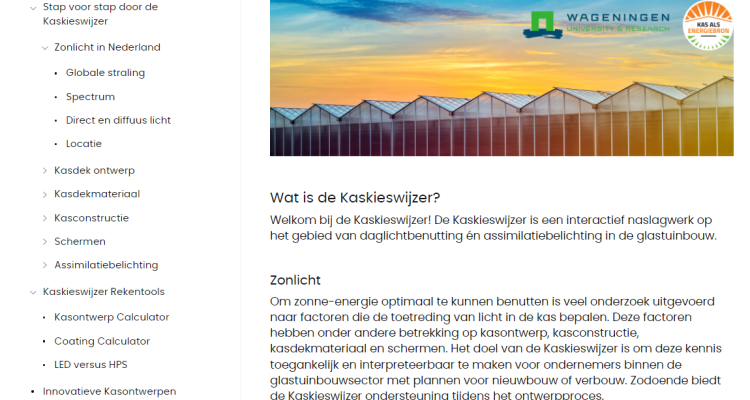
Software
KasKieswijzer: Interactive reference on natural light and illumination
During the last decades, extensive research has been conducted to optimize the utilization of solar energy in greenhouses, focusing on factors that influence light entry. These factors include greenhouse design, construction, covering materials, and screens. The goal of the Greenhouse Lighting Guide is to make this knowledge accessible and interpretable for entrepreneurs in the greenhouse horticulture sector who are planning new construction or renovation projects. Thus, the Greenhouse Lighting Guide provides support during the design process.
Illumination
Electricity use in greenhouse horticulture has rapidly increased over the past 20 years due to the expansion of lighted cultivation areas and a significant increase in installed lighting power. This trend is accompanied by developments in lighting systems that have improved efficiency and control. For example, LEDs can be switched on and off quickly, are dimmable, and have adjustable spectra. The Greenhouse Lighting Guide provides an overview of the knowledge being developed in the quest for optimal lighting for each crop.
Why the KasKieswijzer?
The Greenhouse Lighting Guide and many of the underlying research projects have been carried out for the Dutch innovation program "Kas als Energiebron" which aims for a fully sustainable and economically viable energy supply for the greenhouse horticulture sector. Optimal utilization of solar energy plays a crucial role in this. First, because sunlight is a source of heating energy for greenhouses. Second because sunlight drives photosynthesis, thereby enabling crop production. Additionally, it is essential that the electricity used for lighting is utilized optimally.
The KasKieswijzer is funded by the Ministry of LNV and Stichting Programmafonds Glastuinbouw.
https://wiki.groenkennisnet.nl/space/KAS